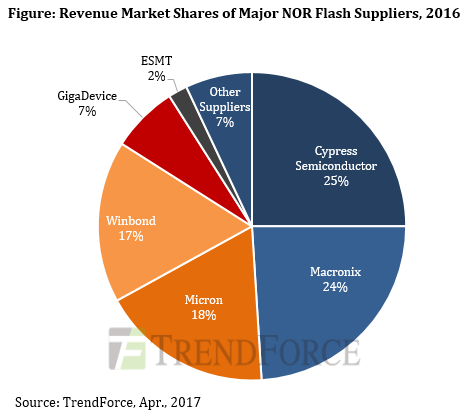The prices of NOR Flash will go up sequentially by at least 5% on average for every quarter in 2017 as its market benefits from the abundant releases of smartphones featuring AMOLED display during the year, TrendForce reports. Besides the general adoption of AMOLED in the smartphone market, the expansion in the production of ICs for Touch with Display Driver Integration (TDDI) is driving the need for NOR Flash as well. From the supply side, major manufacturers such as Micron and GigaDevice have reduced their NOR Flash production. Tight supply and rising demand therefore will keep prices of NOR Flash on an uptrend to the end of this year.
Looking at the NOR Flash industry, Micron and Cypress Semiconductor are providers of high-end and high-density products belonging to the 64/128Mb bracket. Winbond and Macronix target the mid-range market segment that include products having densities of 16, 32 and 64Mb. GigaDevice is the supplier of low-end NOR Flash devices with densities of 1~2Mb and 512kb. The 2016 ranking of market share in revenue put Cypress on top with 25%, Macronix at second place with 24% and Micron at third place with 18%.
China-based GigaDevice in the past had received government subsidies for wafers and was thus able to dump NOR Flash products on the market. However, wafer suppliers for strategic reason can no longer participate in the subsidy scheme. Consequently, GigaDevice’s NOR Flash capacity has contracted due to having a lower wafer inventory than before.
Major international suppliers Micron and Cypress have also scaled back their NOR Flash production. Cypress is reducing NOR Flash in its product mix to focus more on supplying ICs for automotive and industrial applications. Micron will also affect the entire NOR Flash market as the company plans to sell one of its 8-inch wafer fabs.
On the demand front, NOR Flash market is going to witness a large wave of demand resulted from the increasing use of AMOLED panels by smartphone makers. TrendForce points out that demand for AMOLED smartphone panels has risen for two consecutive years. Annual shipments of AMOLED smartphone panels surpassed 300 million units for the first time in 2016 and may reach 500 million units this year owing to the release of the next iPhone.
The complexity of AMOLED panel production often results in mura defects that are located differently on products of the same batch run. To ensure consistency in product quality, manufacturers have set up automated inspection and repair processes. Codes that compensate the possible defect for each panel are stored in a separate, implanted NOR Flash chip because currently there is no economical way to integrate de-mura function into the AMOLED driver IC. In sum, NOR Flash for now is an important part of the AMOLED panel production. Booming demand for AMOLED smartphone panels will contribute to a leap NOR Flash demand as well.

NOR Flash is also needed in TDDI solutions to store the firmware that has become too big for the integrated driver ICs. After a period of development, more TDDI-related IC products have arrived on the market since the second half of 2016. TrendForce therefore expects shipments of LCD-based In-Cell touch panels with TDDI to grow rapidly this year. TrendForce furthermore estimates that the penetration of TDDI solutions in the smartphone display market to reach 10% this year, up from 5% last year. Likewise, the increasing deployment of TDDI will greatly boost NOR Flash demand.

